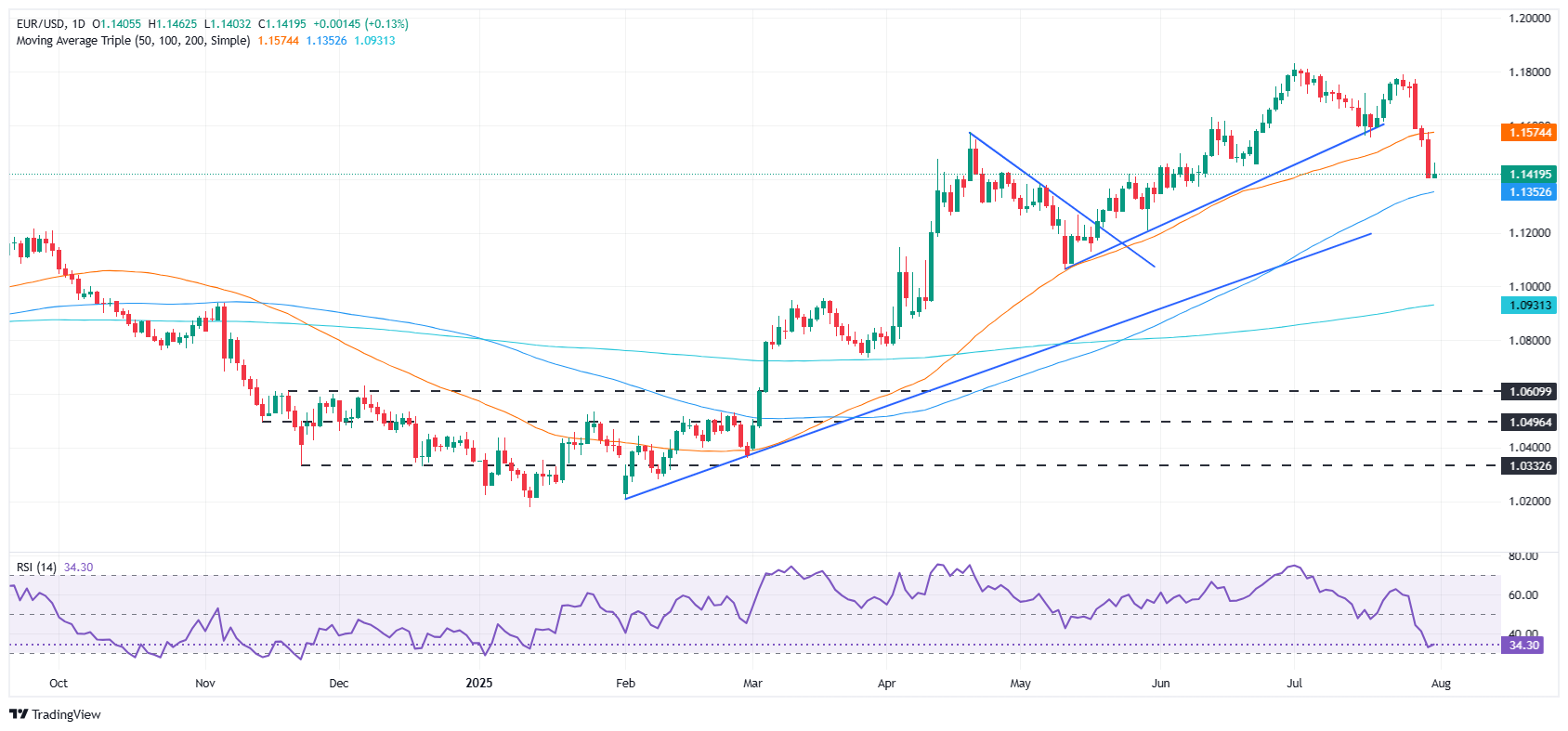- EUR/USD advances 0.10% to 1,1417 despite the strongest data of inflation and employment in the US.
- The U.S. underlying PCE rises to 2.8% year -on -year; Initial unemployment subsidy applications fall to 218K.
- The Fed keeps the rates in a 9–2 vote; Powell rejects the chances of cutting in September.
The EUR/USD regained ground on Thursday, raising a modest 0.10% after the US data (USA) revealed a strong economy, justifying the reluctance of the Federal Reserve to reduce rates, as observed on Wednesday. At the time of writing, the par is quoted at 1,1417, practically unchanged.
Before the opening of Wall Street, the Fed preferred inflation indicator, the Personal Consumption Expenditure Price Index (PCE), exceeded the estimates and reading of the previous month, indicating that prices are increasing. Other data revealed that the labor market is still resistant, after the number of Americans who requested unemployment subsidies fell below the estimates.
A day ago, the US Central Bank kept the rates without changes, with two dissidents. The governors of the Fed, Michelle Bowman and Christopher Waller, supported a rate of 25 basic points (PB). At the press conference, the president of the FED, Jerome Powell, revealed that a rate cut in September is not a certainty, while adopting an approach meeting by meeting, without hurry to make politics more flexible.
As a result, the US dollar rose, as indicated by the US dollar index (DXY). The DXY, which tracks the yield of six coins against the dollar, advanced 0.16% to 100.05.
On the other side of the Atlantic, inflation in the European Union (EU) seems to be maintained around the 2% target of the European Central Bank (ECB), after the publication of the Consumer Price Index (CPI) in Germany, France, Italy and Spain.
Operators prepare for non -agricultural payroll figures on Friday for July, together with the announcement of the ISM manufacturing PMI and the final consumer’s feeling index of the University of Michigan (UOM).
What moves the market today: the EUR/USD remains firm despite a solid report of unemployment applications in the US.
- Initial unemployment subsidy applications fell to 218,000 for the week that ended on July 26, exceeding 224,000 expectations. The data arrive before the non -agricultural payroll report on July on Friday, where economists predict a gain of 110,000 new jobs.
- The preferred inflation measure of the Federal Reserve, the underlying PCE, increased a 2.8% year -on -year in June, compared to 2.7% in May. Meanwhile, the PCE General accelerated to 2.6%from 2.3%, slightly above the market expectations of 2.5%.
- The Federal Reserve’s monetary policy statement stressed that economic growth was moderated in the first half, although the unemployment rate remains low and inflation remains “somewhat high.”
- In addition, the Committee added that its commitment to achieve maximum employment and 2% inflation and acknowledged that “uncertainty about economic perspectives remains high.”
- The publication of the gross domestic (GDP) figures (GDP) as expected for the second quarter in the US, together with solid NUMBERS of ADP employment change, justified the comments of the president of the Fed, Powell, that the economy does not behave as if the monetary policy were restrictive.
- On the other side of the Atlantic, inflation in Germany fell from 2% to 1.8%, while the figures in Italy decreased from 1.8% to 1.7%. Prices in France remained unchanged at 0.9%, above 0.8%estimates, and Spanish inflation rose from 2.3%to 2.7%.
- As for the monetary policy of the ECB, Deutsche Bank does not expect more cuts and suggests that the next movement would be an increase in the late 2026.
Technical perspective: EUR/USD changes to neutral after staging around 1,1400
The EUR/USD stopped its fall around 1,1401 with buyers emerging at that level, since the simple mobile average (SMA) of 100 days in 1,1361 was under the threat of being broken, if the bassists managed to break the level of 1,1400. The relative force index (RSI) shows that sellers are in charge but are taking a break after falling to 34.60; The RSI rose to 34.70. However, more drop in the pair is expected.
If the EUR/USD falls below 1,1400, the next test would be the 100 -day SMA and 1,1300. On the contrary, if the torque rises above 1,1500, the 50 -day SMA would be available in 1,1572.

EURO – FREQUENT QUESTIONS
The euro is the currency of the 19 countries of the European Union that belong to the Eurozone. It is the second most negotiated currency in the world, behind the US dollar. In 2022, it represented 31 % of all foreign exchange transactions, with an average daily business volume of more than 2.2 billion dollars a day. The EUR/USD is the most negotiated currency pair in the world, with an estimate of 30 %of all transactions, followed by the EUR/JPY (4 %), the EUR/GBP (3 %) and the EUR/AU (2 %).
The European Central Bank (ECB), based in Frankfurt (Germany), is the Eurozone reserve bank. The ECB establishes interest rates and manages monetary policy. The main mandate of the ECB is to maintain price stability, which means controlling inflation or stimulating growth. Its main tool is the rise or decrease in interest rates. Relatively high interest rates (or the expectation of higher types) usually benefit the euro and vice versa. The GOVERNMENT BOOK of the ECB makes decisions about monetary policy in meetings that are held eight times a year. The decisions are made by the directors of the National Banks of the Eurozone and six permanent members, including the president of the ECB, Christine Lagarde.
Eurozone inflation data, measured by the harmonized consumer prices index (IPCA), are an important economic indicator for the euro. If inflation increases more than expected, especially if it exceeds 2% of the ECB, it forces the ECB to rise interest rates to control it again. Relatively high interest rates compared to their counterparts usually benefit the euro, since they make the region more attractive as a place for global investors to deposit their money.
Published data measure the health of the economy and can have an impact on the euro. Indicators such as GDP, manufacturing and services PMIs, employment and consumer trust surveys can influence the direction of the single currency. A strong economy is good for the euro. Not only attracts more foreign investment, but it can encourage the ECB to raise interest rates, which will directly strengthen the euro. Otherwise, if economic data is weak, the euro is likely to fall. The economic data of the four largest economies in the euro zone (Germany, France, Italy and Spain) are especially significant, since they represent 75% of the economy of the euro area.
Another important fact that is published on the euro is the commercial balance. This indicator measures the difference between what a country earns with its exports and what you spend on imports during a given period. If a country produces highly demanded export products, its currency will gain value simply by the additional demand created by foreign buyers seeking to buy those goods. Therefore, a positive net trade balance strengthens a currency and vice versa in the case of a negative balance
Source: Fx Street
I am Joshua Winder, a senior-level journalist and editor at World Stock Market. I specialize in covering news related to the stock market and economic trends. With more than 8 years of experience in this field, I have become an expert in financial reporting.







